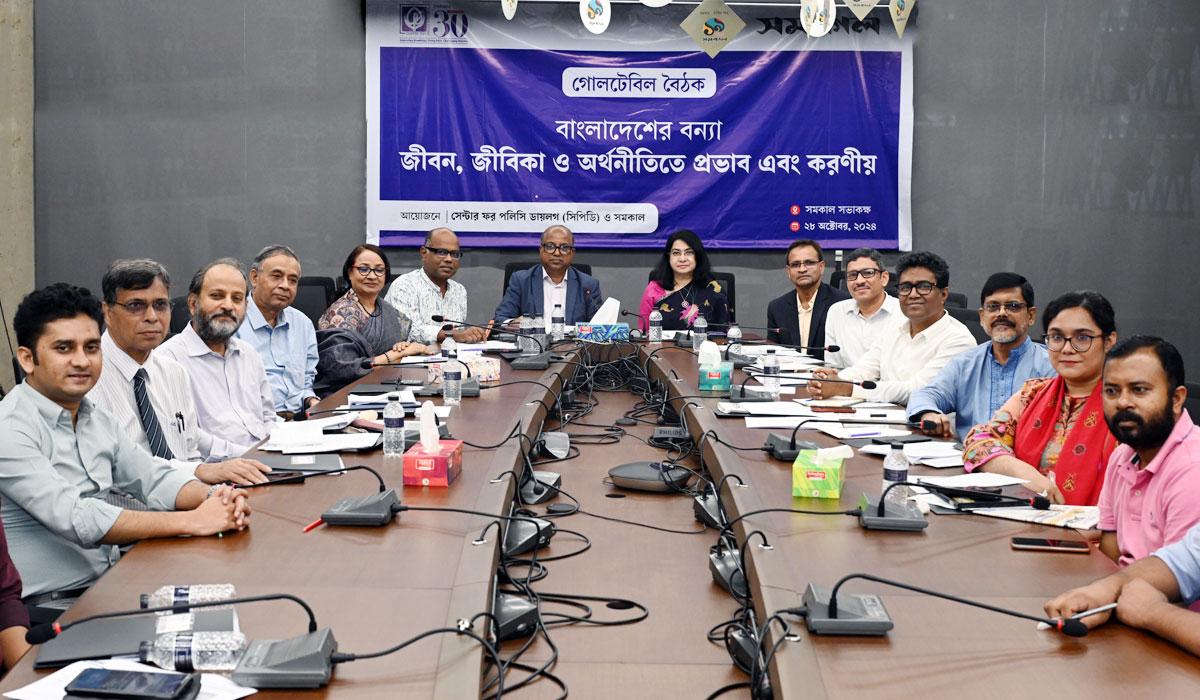
Recent severe flooding in the east has come with fresh experiences. It would, therefore, be very important to deduce from this experience that local involvement and youth participation may play a very key role in the reduction of damages caused by floods. Similarly, because of their multidimensional influence, changes are also needed within the cooperative frameworks. Accompanying that, measures should be — increasing the relief budget, equitable distribution, facilitating easy access to loan facilities, the introduction of insurance schemes, exchanging of weather data with neighbours, arrangement in water transport, developing accurate data repositories, raising the height of embankments, and simplifying flood forecasts for public understanding.
These measures were recommended by the speakers at a roundtable discussion titled ‘Floods in Bangladesh: Impact on Life, Livelihood, and Economy and the Way Forward’, held on Monday, 28 October, 2024. The roundtable was jointly organised by the Centre for Policy Dialogue (CPD) and the Daily Samakal.
CPD’s Executive Director, Dr Fahmida Khatun, highlighted, ‘Climate change is intensifying disasters. Floods initially impact lives and homes, followed by livelihoods, with long-term economic consequences. Data from agencies, including the Bureau of Statistics, show rising economic losses from floods, along with multifaceted effects including loss of life’.
She pointed out that the recent relief distribution was uneven, with some areas receiving less aid and lacking early warnings in the eastern regions. Stronger embankments, essential goods, funds, and accessible loans for livelihoods, especially for women and children left behind, are crucial. She called for collaborative efforts between ministries, development partners, and the private sector to reduce flood impacts.
Water Resources Secretary Mr Nazmul Ahsan remarked, ‘This year’s flooding provided new lessons, and we are planning future strategies with these insights in mind. Weather forecasts are still not user-friendly and are challenging for many to understand. We aim to make flood forecasts more accessible’. He mentioned considering Google notifications for alerts and shared plans to send warnings via SMS, with regional alerts as appropriate.
Mr Ahsan also observed, ‘Unplanned development activities have blocked natural floodwater drainage. With climate change, such severe floods may recur, so we need to be prepared in advance. We are ensuring community participation in every initiative, planning projects based on local feedback, and involving youth in these efforts’.
He announced a campaign for 1 November, National Youth Day, where young people will clean 64 canals across 64 districts and two in Dhaka to foster youth engagement, which he believes will increase government accountability. On flood management, he noted efforts to modernise embankment maintenance and conduct regular river dredging to maintain navigability. The effective Tidal River Management (TRM) approach will be implemented in areas suited to it, such as recently in Bhobodoha in Jessore to address waterlogging.
Additional Secretary of the Ministry of Disaster Management and Relief, Mr K.M. Ali Reza, acknowledged that while adequate relief was available, boat shortages hindered quick distribution in remote areas, necessitating helicopter drops. Future plans include boats for each district, youth involvement for organisational resilience, and expanding disaster insurance. New shelters now provide separate facilities for women and children.
Dr Mahbuba Nasreen of Dhaka University’s Institute of Disaster Management and Vulnerability Studies, underscored the need for integrated efforts, citing coordination challenges that hamper effective action, and suggested increased private sector involvement in disaster management.
Bangladesh Institute of Social Research Trust’s Chairman, Dr Khurshid Alam, called for improved budget management, advocating for a minimum BDT 10 billion emergency budget alongside regular allocations to prevent misappropriation.
BRAC’s Climate Change Program Director, Dr Md. Liaquat Ali, stressed climate and disaster preparedness across all activities and inclusive rehabilitation efforts.
Writer and researcher Mr Gawhar Nayeem Wara, noted youth contributions in flood relief but identified gaps in guidance, which led to inconsistent assistance. He observed that civil society was more vocal on television than active in the field, suggesting that our preparedness is more theoretical than practical.
Dr Mohan Kumar Das of the National Oceanographic and Maritime Institute expressed concerns over the lack of scientific flood damage statistics, questioning whether experts were placed appropriately in such roles.
World Bank Senior Environmental Specialist Dr Ishtiaq Sobhan pointed out that efforts to fight floods often ignore natural dynamics, citing Feni, which is coastal, as an example of disrupted flood plains.
Mr Sheikh Rokon, Associate Editor, Daily Samakal, thanked the participants, noting, ‘For centuries, we have coexisted with floods. In our riverine Bangladesh, floods are ingrained in our life, society, and state memory. This year saw three major floods across different regions, sparking extensive discussions across social media and news outlets beyond government, research bodies, aid agencies, and NGOs.”
Speakers also emphasised, ‘We cannot be complacent, thinking everything has been done and resolved; the recent flooding in the eastern regions has shown us otherwise. Our goal should be to ensure that no individual suffers due to floods or disasters. Flood management strategies must incorporate the perspectives and input of local communities’.
The roundtable was attended by government officials; climate and environmental specialists; research and policy experts; representatives from international organisations; NGO and development sector leaders; private sector and civil society representatives; youth and journalists.



